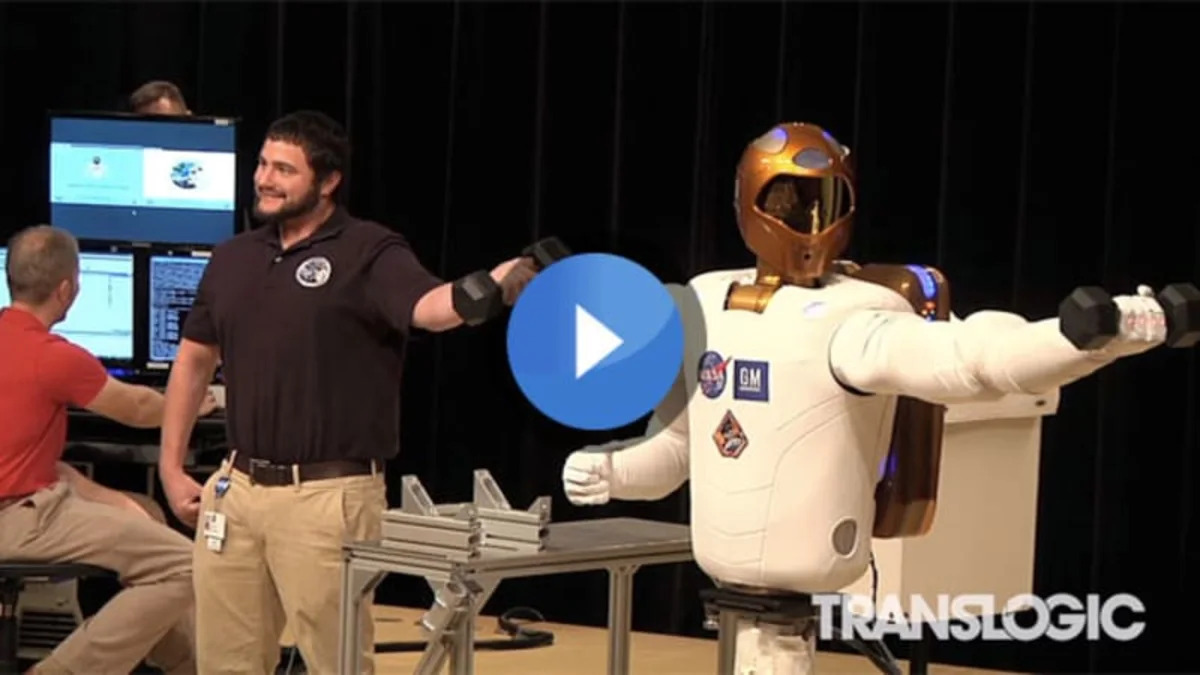First there was Asimo, Honda's friendly and childlike humanoid robot, who dazzled the public by walking on two legs. Then came Toyota's whimsical Partner Robots, which could play musical instruments. Now we have Robonaut 2, a menacing machine GM helped develop in a partnership with NASA.
Wearing a metallic bronze helmet with an opaque face shield, "R2" looks more than a little influenced by the violent video game Halo. Never mind that R2 doesn't have legs, as the massive and muscular humanoid is imposing enough without them. Though it measures just 3'4" GM says the torso and arms are about the size of a seven-foot-tall human. The bot has an eight-foot wingspan – or 17 inches longer than swimmer Michael Phelps.
Unlike the robots from the Japanese car companies, this one is designed for serious business, "not just to play games," said GM Vice President of Global R&D Alan Taub, as he introduced R2 to the media. R2 is the product of a partnership GM began back in 2007, when it cut a deal to co-fund the development of a second-generation humanoid robot to be used on the International Space Station. GM has had five or six people co-located at NASA's Johnson Space Center in Houston, working alongside ten times as many NASA engineers ever since.
GM says R2 is significant because it's the most dexterous humanoid robot in existence. With jointed arms and having hands similar to humans, R2 is strong enough to lift and hold 20 pounds in each. Its head can move in three degrees, so it can look around, and the computer system housed in its torso is programmed to do some sophisticated operations. In one demonstration, GM showed R2 opening a safety cover and flipping a switch. But when its human handler closed the cover before it could flip the switch, R2 recognized the change and opened the cover again, before attempting to flip the switch.
It's artificial intelligence like this that NASA hopes will make R2 a productive member of the International Space Station community. The robot is still technically a prototype, and was scheduled to launch aboard Space Shuttle Discovery in November, but the mission was postponed until February due to leaking hydrogen gas. R2 would be the first humanoid robot in space.
GM's interest in robotics is two-fold. The first is that the carmaker is already heavily invested in automation in its manufacturing facilities, and the second is that many of the sensory technologies employed in state-of-the-art artificial intelligence can potentially be used to make cars safer. GM doesn't plan to build a fleet of R2's to set loose in its assembly plants or drive its cars, but use specific tech bits to improve its existing manufacturing robots or develop the next generation of vehicle safety systems such as lane departure and accident avoidance systems.
Wearing a metallic bronze helmet with an opaque face shield, "R2" looks more than a little influenced by the violent video game Halo. Never mind that R2 doesn't have legs, as the massive and muscular humanoid is imposing enough without them. Though it measures just 3'4" GM says the torso and arms are about the size of a seven-foot-tall human. The bot has an eight-foot wingspan – or 17 inches longer than swimmer Michael Phelps.
Unlike the robots from the Japanese car companies, this one is designed for serious business, "not just to play games," said GM Vice President of Global R&D Alan Taub, as he introduced R2 to the media. R2 is the product of a partnership GM began back in 2007, when it cut a deal to co-fund the development of a second-generation humanoid robot to be used on the International Space Station. GM has had five or six people co-located at NASA's Johnson Space Center in Houston, working alongside ten times as many NASA engineers ever since.
GM says R2 is significant because it's the most dexterous humanoid robot in existence. With jointed arms and having hands similar to humans, R2 is strong enough to lift and hold 20 pounds in each. Its head can move in three degrees, so it can look around, and the computer system housed in its torso is programmed to do some sophisticated operations. In one demonstration, GM showed R2 opening a safety cover and flipping a switch. But when its human handler closed the cover before it could flip the switch, R2 recognized the change and opened the cover again, before attempting to flip the switch.
GM's interest in robotics is two-fold. The first is that the carmaker is already heavily invested in automation in its manufacturing facilities, and the second is that many of the sensory technologies employed in state-of-the-art artificial intelligence can potentially be used to make cars safer. GM doesn't plan to build a fleet of R2's to set loose in its assembly plants or drive its cars, but use specific tech bits to improve its existing manufacturing robots or develop the next generation of vehicle safety systems such as lane departure and accident avoidance systems.


Sign in to post
Please sign in to leave a comment.
Continue